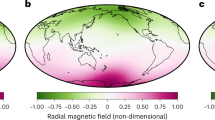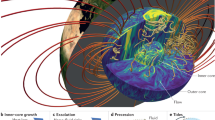Abstract
Mercury has a global magnetic field of internal origin and it is thought that a dynamo operating in the fluid part of Mercury’s large iron core is the most probable cause. However, the low intensity of Mercury’s magnetic field—about 1% the strength of the Earth’s field—cannot be reconciled with an Earth-like dynamo. With the common assumption that Coriolis and Lorentz forces balance in planetary dynamos1, a field thirty times stronger is expected. Here I present a numerical model of a dynamo driven by thermo-compositional convection associated with inner core solidification. The thermal gradient at the core–mantle boundary is subadiabatic2,3, and hence the outer region of the liquid core is stably stratified with the dynamo operating only at depth, where a strong field is generated. Because of the planet’s slow rotation the resulting magnetic field is dominated by small-scale components that fluctuate rapidly with time. The dynamo field diffuses through the stable conducting region, where rapidly varying parts are strongly attenuated by the skin effect, while the slowly varying dipole and quadrupole components pass to some degree. The model explains the observed structure and strength of Mercury’s surface magnetic field and makes predictions that are testable with space missions both presently flying and planned.
This is a preview of subscription content, access via your institution
Access options
Subscribe to this journal
Receive 51 print issues and online access
$199.00 per year
only $3.90 per issue
Buy this article
- Purchase on Springer Link
- Instant access to full article PDF
Prices may be subject to local taxes which are calculated during checkout



Similar content being viewed by others
References
Stevenson, D. J. Planetary magnetic fields. Earth Planet. Sci. Lett. 208, 1–11 (2003)
Schubert, G., Ross, M. N., Stevenson, D. J. & Spohn, T. Mercury’s thermal history and the generation of its magnetic field. In Mercury (eds Vilas, F., Chapman, C. R. & Matthews, M. S.) 429–460 (Univ. Arizona Press, Tucson, 1988)
Hauck, S. A., Dombard, A. J., Phillips, R. J. & Solomon, S. C. Internal and tectonic evolution of Mercury. Earth Planet. Sci. Lett. 222, 713–728 (2004)
Ness, N. F. The magnetic field of Mercury. Phys. Earth Planet. Inter. 20, 209–217 (1979)
Connerney, J. E. P. & Ness, N. F. Mercury’s magnetic field and interior. In Mercury (eds Vilas, F., Chapman, C. R. & Matthews, M. S.) 494–513 (Univ. Arizona Press, Tucson, 1988)
Aharonson, O., Zuber, M. T. & Solomon, S. C. Crustal remanence in an internally magnetized non-uniform shell: a possible source for Mercury’s magnetic field?. Earth Planet. Sci. Lett. 218, 261–268 (2004)
Christensen, U. R. & Aubert, J. Scaling properties of convection-driven dynamos in rotating spherical shells and application to planetary magnetic fields. Geophys. J. Int. 166, 97–114 (2006)
Heimpel, M. H., Aurnou, J. M., Al-Shamali, F. M. & Gomez Perez, N. A numerical study of dynamo action as function of spherical shell geometry. Earth Planet. Sci. Lett. 236, 542–557 (2005)
Stanley, S., Bloxham, J., Hutchinson, W. E. & Zuber, M. T. Thin shell dynamo models consistent with Mercury’s weak observed magnetic field. Earth Planet. Sci. Lett. 234, 27–38 (2005)
Takahashi, F. & Matsushima, M. Dipolar and non-dipolar dynamos in thin shell geometry with implications for the magnetic field of Mercury. Geophys. Res. Lett. 33 L10202 doi: 10.1029/2006GL02579 (2006)
Turner, J. S. Buoyancy Effects in Fluids Ch. 8 (Cambridge Univ. Press, Cambridge, 1973)
Braginsky, S. I. & Roberts, P. H. Equations governing convection in Earth’s core and the geodynamo. Geophys. Astrophys. Fluid Dyn. 79, 1–97 (1995)
Lister, J. R. & Buffett, B. A. The strength and efficiency of thermal and compositional convection in the geodynamo. Phys. Earth Planet. Inter. 91, 17–30 (1995)
Kutzner, C. & Christensen, U. R. Simulated geomagnetic reversals and preferred virtual geomagnetic pole paths. Geophys. J. Int. 157, 1105–1118 (2004)
Olson, P. & Christensen, U. R. Dipole moment scaling for convection-driven planetary dynamos. Earth Planet. Sci. Lett. 250, 561–571 (2006)
Zhang, K. & Schubert, G. Teleconvection: remotely driven thermal convection in rotating stratified spherical layers. Science 290, 1944–1947 (2000)
Olsen, N. et al. CHAOS—a model of the Earth’s magnetic field derived from CHAMP, Ørsted, and SAC-C magnetic satellite data. Geophys. J. Int. 166, 67–75 (2006)
Christensen, U. R. & Tilgner, A. Power requirement of the geodynamo from ohmic losses in numerical and laboratory dynamos. Nature 429, 169–171 (2004)
Stevenson, D. J. Reducing the non-axisymmetry of a planetary dynamo and an application to Saturn. Geophys. Astrophys. Fluid Dyn. 21, 113–127 (1982)
Hollerbach, R. & Jones, C. A. Influence of the Earth’s inner core on geomagnetic fluctuations and reversals. Nature 365, 541–543 (1993)
Van Hoolst, T. & Jacobs, C. Mercury’s tides and internal structure. J. Geophys. Res. 108 5121 doi: 10.1029/2003JE002126 (2003)
Peale, S. J., Phillips, R. J., Solomon, S. C., Smith, D. E. & Zuber, M. T. A procedure for determining the nature of Mercury’s core. Meteorit. Planet. Sci. 37, 1269–1283 (2002)
Acknowledgements
Constructive reviews by S. Stanley and D. Stevenson are appreciated.
Author information
Authors and Affiliations
Corresponding author
Ethics declarations
Competing interests
Reprints and permissions information is available at www.nature.com/reprints. The author declares no competing financial interests.
Rights and permissions
About this article
Cite this article
Christensen, U. A deep dynamo generating Mercury’s magnetic field. Nature 444, 1056–1058 (2006). https://doi.org/10.1038/nature05342
Received:
Accepted:
Issue Date:
DOI: https://doi.org/10.1038/nature05342
This article is cited by
-
Resistivity of solid and liquid Fe–Ni–Si with applications to the cores of Earth, Mercury and Venus
Scientific Reports (2022)
-
Review of Mercury’s dynamic magnetosphere: Post-MESSENGER era and comparative magnetospheres
Science China Earth Sciences (2022)
-
Dynamics and Evolution of Venus’ Mantle Through Time
Space Science Reviews (2022)
-
Interiors of Earth-Like Planets and Satellites of the Solar System
Surveys in Geophysics (2022)
-
The palaeoinclination of the ancient lunar magnetic field from an Apollo 17 basalt
Nature Astronomy (2021)
Comments
By submitting a comment you agree to abide by our Terms and Community Guidelines. If you find something abusive or that does not comply with our terms or guidelines please flag it as inappropriate.



